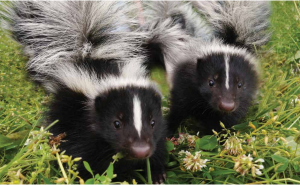Theresa Wallace

There have been many reported sightings of skunks in and around Old Ottawa East this spring and summer; humans know to avoid them, but dogs seem more curious.
In the opening days of the pandemic, when we were all told to stay home, I looked out my kitchen window and saw a skunk waddling down the sidewalk. It was bigger than I imagined a skunk could be. And it was tough-looking—its fur long and matted, its stripes more yellow than white. This was my first sighting of the Mephitis mephitis in the four decades we’d lived in our house. Perhaps it was the part of the advance guard.
“In the last two years, I have seen more skunks in our area than I have in the rest of my life,” says Melanie Roet, whose dog was sprayed at dusk in July in the backyard of her house on Merritt Avenue. Cashew is a three-year-old miniature poodle who weighs ten pounds.
“He was sprayed directly in the face and was very agitated,” Roet says. She used the recommended peroxide/baking soda/ liquid soap mixture (see recipe in the sidebar) twice. “We learned afterwards it is best used on a dry animal, so once you rinse your pet it won’t work as well.” Spray from a skunk can be smelled kilometres away, and neighbours warned her to treat Cashew outside. “It is instinct to want to bring your pet in to wash them in the tub, but that will get the smell all over the house. Our neighbours across the street learned this the hard way when their cat was sprayed last summer. We took note and stayed outside to treat Cashew.”
Neighbours with more experience also told her the smell would remain in Cashew’s snout and come out each time he got wet. “Every time we walk in the rain, we have a lingering reminder.” Roet now tries to avoid being outside with Cashew at dusk or dawn. “We also keep him on a shorter leash when walking, and we purposely talk or make a little noise in areas where we have seen skunks to let them know we are coming.”
Kate MacNeil says making some noise is exactly the right thing to do. “And when you let your dog out at night, flick on the porch light, whistle, talk, give skunks all the warning they need to move along,” advises MacNeil, executive director of the non-profit Ottawa-Carleton Wildlife Centre.
MacNeil says skunks would rather avoid a confrontation, and people usually understand what it means when a skunk raises and fluffs up its tail, stamps its front feet and shows its backside. “Unfortunately, these warning signs don’t seem as effective in discouraging dogs, who do occasionally get sprayed.”
The Ottawa-Carleton Wildlife Centre has not received more than the usual number of skunk inquiries this year. Neither has City Councillor Shawn Menard’s office. The City of Ottawa says it doesn’t keep track. But MacNeil says when people see more of any wild animal than usual in a residential neighbourhood, it can mean this animal has been displaced from its usual habitat by human encroachment.
She encourages people to be patient. “Reports indicate the birthing season was earlier this year, but skunks are usually born in the middle of May. In early summer, you will sometimes see young skunks because by then they are able to come out with their mom to forage. Skunks are burrowers and may make their den under a step or a shed. The mother skunk gives birth to her young around people because there are fewer natural predators in human habitats, but her goal is to move the babies to a more natural area as soon as they are mobile. Give skunks time and space and eventually they will leave.”
Skunk remedy for dogs
The Ottawa-Carleton Wildlife Centre and the Ottawa Humane Society both recommend the following remedy if your dog gets sprayed by a skunk. Mix together: one quart (or four cups) of 3 percent hydrogen peroxide, 1/4 cup baking soda, and one teaspoon of liquid soap. It’s important to use the mixture right away. Apply it carefully with a spray bottle or a cloth, leave it on your dog for five minutes and then rinse thoroughly. (This mixture only lasts for 24 hours, so you might want to halve the ingredients.) See their websites for more comprehensive instructions.







